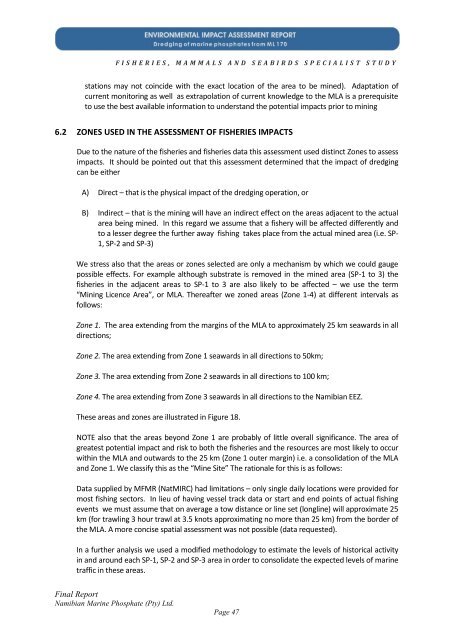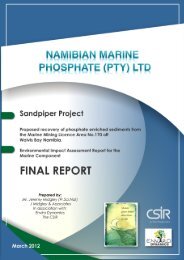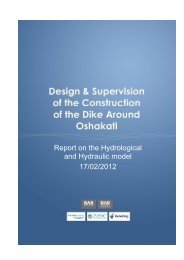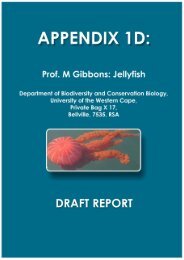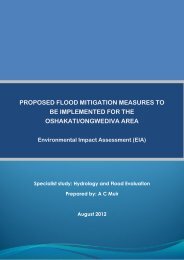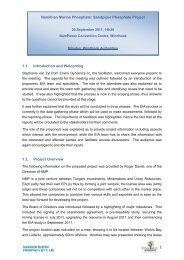Fisheries - Enviro Dynamics Namibia
Fisheries - Enviro Dynamics Namibia
Fisheries - Enviro Dynamics Namibia
You also want an ePaper? Increase the reach of your titles
YUMPU automatically turns print PDFs into web optimized ePapers that Google loves.
F I S H E R I E S , M A M M A L S A N D S E A B I R D S S P E C I A L I S T S T U D Y<br />
stations may not coincide with the exact location of the area to be mined). Adaptation of<br />
current monitoring as well as extrapolation of current knowledge to the MLA is a prerequisite<br />
to use the best available information to understand the potential impacts prior to mining<br />
6.2 ZONES USED IN THE ASSESSMENT OF FISHERIES IMPACTS<br />
Due to the nature of the fisheries and fisheries data this assessment used distinct Zones to assess<br />
impacts. It should be pointed out that this assessment determined that the impact of dredging<br />
can be either<br />
A) Direct – that is the physical impact of the dredging operation, or<br />
B) Indirect – that is the mining will have an indirect effect on the areas adjacent to the actual<br />
area being mined. In this regard we assume that a fishery will be affected differently and<br />
to a lesser degree the further away fishing takes place from the actual mined area (i.e. SP-<br />
1, SP-2 and SP-3)<br />
We stress also that the areas or zones selected are only a mechanism by which we could gauge<br />
possible effects. For example although substrate is removed in the mined area (SP-1 to 3) the<br />
fisheries in the adjacent areas to SP-1 to 3 are also likely to be affected – we use the term<br />
“Mining Licence Area”, or MLA. Thereafter we zoned areas (Zone 1-4) at different intervals as<br />
follows:<br />
Zone 1. The area extending from the margins of the MLA to approximately 25 km seawards in all<br />
directions;<br />
Zone 2. The area extending from Zone 1 seawards in all directions to 50km;<br />
Zone 3. The area extending from Zone 2 seawards in all directions to 100 km;<br />
Zone 4. The area extending from Zone 3 seawards in all directions to the <strong>Namibia</strong>n EEZ.<br />
These areas and zones are illustrated in Figure 18.<br />
NOTE also that the areas beyond Zone 1 are probably of little overall significance. The area of<br />
greatest potential impact and risk to both the fisheries and the resources are most likely to occur<br />
within the MLA and outwards to the 25 km (Zone 1 outer margin) i.e. a consolidation of the MLA<br />
and Zone 1. We classify this as the “Mine Site” The rationale for this is as follows:<br />
Data supplied by MFMR (NatMIRC) had limitations – only single daily locations were provided for<br />
most fishing sectors. In lieu of having vessel track data or start and end points of actual fishing<br />
events we must assume that on average a tow distance or line set (longline) will approximate 25<br />
km (for trawling 3 hour trawl at 3.5 knots approximating no more than 25 km) from the border of<br />
the MLA. A more concise spatial assessment was not possible (data requested).<br />
In a further analysis we used a modified methodology to estimate the levels of historical activity<br />
in and around each SP-1, SP-2 and SP-3 area in order to consolidate the expected levels of marine<br />
traffic in these areas.<br />
Final Report<br />
<strong>Namibia</strong>n Marine Phosphate (Pty) Ltd.<br />
Page 47


